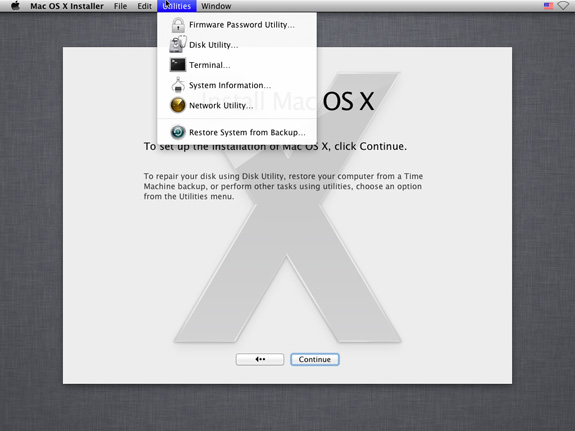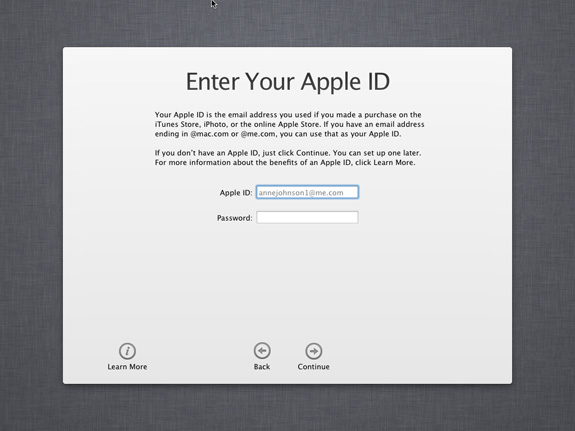Back to the Mac: OS X 10.7 Lion Review
by Andrew Cunningham, Kristian Vättö & Anand Lal Shimpi on July 20, 2011 8:30 AM ESTLike Windows 7, the Lion installer creates a small hidden system partition on your hard drive - in Lion, this recovery partition is to be used in lieu of your install CD in the event that you need to run diagnostics or reinstall your OS (if you burned Lion to a DVD, booting from it will get you the same interface and tools as the recovery partition, so pay attention). This partition is normally hidden from the end user in the Finder and Disk Utility, but is selectable when pressing the alt/option key at boot (and visible in System Profiler as a 650MB partition on your hard drive).

Missing from this list are the System Profiler and the Password Reset utility - I don’t know why the former is gone, but the latter is presumably missing for security reasons, since basically anyone armed with the Password Reset utility and physical access to your machine can change any local account’s password at will. To replace the functionality of this tool, Lion now gives you the option to recover your account password if you associate it with your Apple ID, which should work fine for most individuals (though perhaps not so much for system administrators).
If you didn’t burn a disc as outlined previously, the recovery partition also gives you your only option for a clean install of Lion - erase your hard drive using Disk Utility and then elect to install a fresh copy of Lion. At this point, you will be prompted for your Mac’s serial number, which is then communicated to Apple, and if it clears your Mac will re-download (sigh) and re-install the OS. This serial number check is OS X’s first real implementation of what anyone could call activation, though it’s worth noting that if you install Lion from a .DMG copied to another disk, the OS will still install without any checks.
The last thing the recovery partition is used for is to store FileVault information, which we’ll talk more about later on in the review.
Once the installer is complete, people who did an upgrade install will be able to start using Lion pretty much immediately - aside from the (optional) registration form, there’s not really anymore to it. People who did a clean install (or who have new Macs preloaded with Lion) will be taken through the standard first-time setup process, which is mostly identical to that of OS X versions past with a couple of changes: first, the customary OS X welcome movie has been completely removed (possibly in another effort to save on download size). Second, users are now given the option to associate their Mac with an Apple ID, and to give that Apple ID the ability to recover their local account password. Last, on Macs with multitouch-enabled trackpads and mice, the OS literally forces you to use a two-fingered scrolling gesture to click the “Start Using OS X” button. How’s that for pushing new features?












106 Comments
View All Comments
VMFnet - Friday, July 22, 2011 - link
I just installed Lion on a OCZ Vertex2 SSD and it still doesn't support TRIM. I guess support for this feature is limited to stock Apple SSDs only.Sapan - Friday, July 22, 2011 - link
Thanks for the reply. It is a shame that there still is no TRIM support.In the mean time I would recommend checking out a 3rd party program called TRIM Enabler:
http://www.groths.org/?page_id=322
Though the program is designed for Snow Leopard it works for Lion, but they are making a new version for Lion.
mdlam - Friday, July 22, 2011 - link
I love how these diehard Apple fans are trying to resolve their discomforting feelings of exorbitant expenditure to Apple byA: Unreasonably denigrating other competitive alternatives.
B: Exaggerating the usefulness of certain proprietary tools.
C: Empathizing with the company's goals/missions/values
All to resolve the realization that they are paying more money than what they are getting, which is...
A totally outdated OS made to look streamline
A pretty cool looking computer that uses tunnel fans (which are extremely loud) and likes to overheat.
I used Snow Leopard on my Mac Mini for about 2 months and hated it. I think people force themselves to like OSX just because their laptop looks cool.
Horrible graphics speeds. Their BEST video card that you can fit into a their $4500 Mac Pro, is a ATI 6500 series, which is like a 100 dollar card, and offers pathetic performance for gaming--I had a 6950 2gb and that was barely enough. You can argue that Mac pro's should be used for graphics design and other things and not gaming. If that's the case I don't see why they don't put a FireGL or other designer cards in. In any case, who buys a $4500 computer that comes with a bullcrap video card? Some people are IDIOTS.
mdlam - Friday, July 22, 2011 - link
Edit: A $170 dollar video card, 6870 1gb...Which is a complete piece of garbage card that is 30% slower than the 5970 1gb. Guess how much the upgrade is? $200.Post is based off of cognitive dissonance theory
parlour - Monday, July 25, 2011 - link
Macs don’t seem to be the right choice for you. That’s alright. Just don’t claim that everyone else has the same needs as you.sjinsjca - Saturday, July 23, 2011 - link
The test with the SSD is intriguing but there's a possibility that the FileVault performance hit might be less in the case of a conventional hard disk.Reason: hard disks are slower than SSDs, so there would be more idle states in which the OS could be performing encryption/decryption tasks.
Worth a spot-check.
EnerJi - Sunday, July 24, 2011 - link
That's a great point. I'd also love to know if the performance impact decreases with an HDD.johnmacward - Tuesday, July 26, 2011 - link
What annoys me is the fact that the recovery partition doesn't keep a copy of the Lion installer for instant re-installation - and with a bit of Apple magic even a copy that updates as the OS updates.A download each time is a possibly expensive prospect considering we all have data caps of some kind.
It also turns a reinstall into a shockingly long 4 hour job which is a major pain.
luca108 - Tuesday, July 26, 2011 - link
Small detail, but in the review you said you could only launch Launchpad by clicking the dock icon or using spotlight, but you can also set it as a hot corner. This is what I personally do... top left corner set for Launchpad and I can quickly get in and out of it to find my apps and utilities.I'm not suggesting it's quicker than using an apps stack on the dock... actually, its the exact same. But it definitely is faster than clicking the Launchpad dock icon or using spotlight to launch it.
Thrakazog - Tuesday, July 26, 2011 - link
Does anyone know if Lion extended trim support to 3rd party SSD's, instead of only the ones apple provides ?